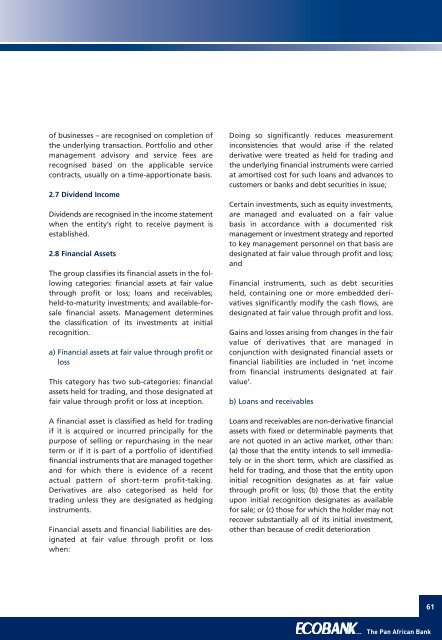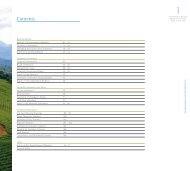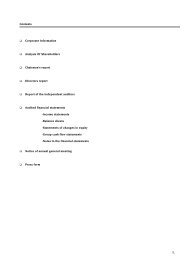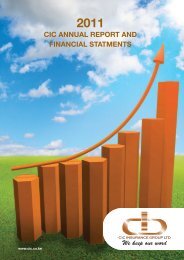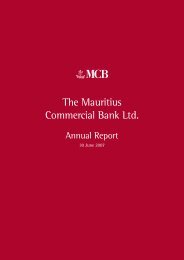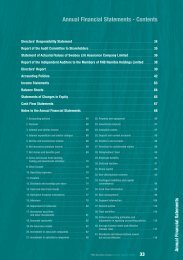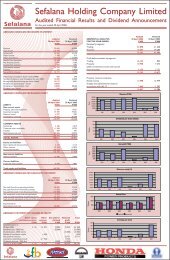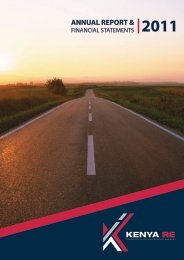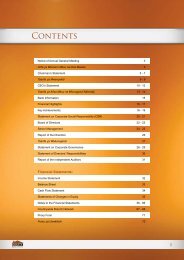Annual Report 2007 - Investing In Africa
Annual Report 2007 - Investing In Africa
Annual Report 2007 - Investing In Africa
You also want an ePaper? Increase the reach of your titles
YUMPU automatically turns print PDFs into web optimized ePapers that Google loves.
of businesses – are recognised on completion of<br />
the underlying transaction. Portfolio and other<br />
management advisory and service fees are<br />
recognised based on the applicable service<br />
contracts, usually on a time-apportionate basis.<br />
2.7 Dividend <strong>In</strong>come<br />
Dividends are recognised in the income statement<br />
when the entity’s right to receive payment is<br />
established.<br />
2.8 Financial Assets<br />
The group classifies its financial assets in the following<br />
categories: financial assets at fair value<br />
through profit or loss; loans and receivables;<br />
held-to-maturity investments; and available-forsale<br />
financial assets. Management determines<br />
the classification of its investments at initial<br />
recognition.<br />
a) Financial assets at fair value through profit or<br />
loss<br />
This category has two sub-categories: financial<br />
assets held for trading, and those designated at<br />
fair value through profit or loss at inception.<br />
A financial asset is classified as held for trading<br />
if it is acquired or incurred principally for the<br />
purpose of selling or repurchasing in the near<br />
term or if it is part of a portfolio of identified<br />
financial instruments that are managed together<br />
and for which there is evidence of a recent<br />
actual pattern of short-term profit-taking.<br />
Derivatives are also categorised as held for<br />
trading unless they are designated as hedging<br />
instruments.<br />
Financial assets and financial liabilities are designated<br />
at fair value through profit or loss<br />
when:<br />
Doing so significantly reduces measurement<br />
inconsistencies that would arise if the related<br />
derivative were treated as held for trading and<br />
the underlying financial instruments were carried<br />
at amortised cost for such loans and advances to<br />
customers or banks and debt securities in issue;<br />
Certain investments, such as equity investments,<br />
are managed and evaluated on a fair value<br />
basis in accordance with a documented risk<br />
management or investment strategy and reported<br />
to key management personnel on that basis are<br />
designated at fair value through profit and loss;<br />
and<br />
Financial instruments, such as debt securities<br />
held, containing one or more embedded derivatives<br />
significantly modify the cash flows, are<br />
designated at fair value through profit and loss.<br />
Gains and losses arising from changes in the fair<br />
value of derivatives that are managed in<br />
conjunction with designated financial assets or<br />
financial liabilities are included in ‘net income<br />
from financial instruments designated at fair<br />
value’.<br />
b) Loans and receivables<br />
Loans and receivables are non-derivative financial<br />
assets with fixed or determinable payments that<br />
are not quoted in an active market, other than:<br />
(a) those that the entity intends to sell immediately<br />
or in the short term, which are classified as<br />
held for trading, and those that the entity upon<br />
initial recognition designates as at fair value<br />
through profit or loss; (b) those that the entity<br />
upon initial recognition designates as available<br />
for sale; or (c) those for which the holder may not<br />
recover substantially all of its initial investment,<br />
other than because of credit deterioration<br />
61<br />
... The Pan <strong>Africa</strong>n Bank


